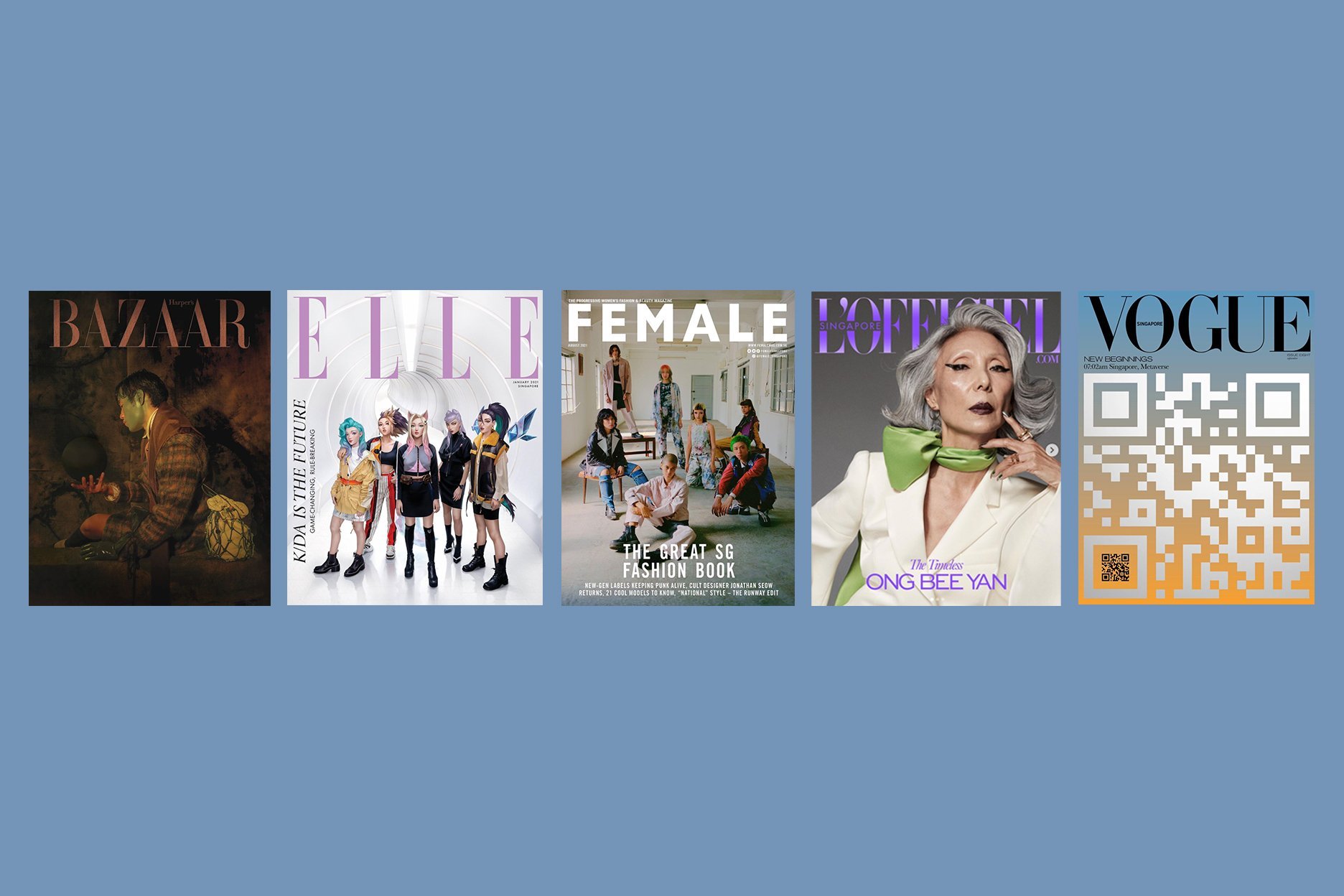My Own Words: Weiqi Yap
Fashion on Display in Singapore
By Weiqi Yap
In May 2022, I opened Fashion On Display, an independent fashion curation studio and experimental fashion gallery based in Singapore. In this piece, I hope to share my reasons for setting up an independent fashion exhibition space in Singapore; and to reflect on the curatorial process behind its first exhibition, ‘Dressing for the Dream Space’.
Weiqi Yap in Fashion on Dispay. Image courtesy of Najja Chaliza Gaswara.
It would be impossible to explore the idea of an experimental fashion gallery without acknowledging the pioneering work of fashion exhibition-maker Judith Clark, whom I had the immense privilege of training under when pursuing my graduate degree in fashion curation at the London College of Fashion. From 1997 to 2005, Clark curated 21 fashion exhibitions in the Judith Clark Costume Gallery,1 a 9 by 4 metre space in Notting Hill. The fashion exhibitions held in this space were notably experimental, each challenging a different facet of dress and fashion display.
‘Dressing for the Dream Space’, 2022, exhibition view at Fashion On Display. Image courtesy of Fashion On Display.
Clark’s trailblazing endeavour to reframe the presentation of fashion and dress was a key point of inspiration for the opening of Fashion On Display. When I decided to start my own fashion exhibition space, it was important for Fashion On Display to not be an interdisciplinary art space, but one that was distinctively and exclusively dedicated to exploring fashion and dress. Singapore has a rich scene of independent art spaces, with several mushrooming in recent years as more and more artists carve out spaces of their own for their practices. When it comes to independent fashion spaces, however, there is a significant lack of spaces that allow people to engage with fashion in contexts that reside outside of commerce and consumption. With the exception of the permanent exhibits found in our national museums, the only other spaces or opportunities to experience fashion in a cultural, educational, or artistic context, are at one-off events or festivals held by organisations such as Fashion Revolution Singapore, or the recent The Non Season—which featured a range of fashion-adjacent activities and events including mending workshops, live-drawing sessions, and walking tours on the history of Orchard Road.
‘Dressing for the Dream Space’, 2022, exhibition view at Fashion On Display. Image courtesy of Fashion On Display.
Fashion exhibitions hold latent potential to suspend fashion and dress from a commercial context. Garments on display become objects of observation, as they are encountered in contexts that encourage curious scrutiny and thoughtful reflection. Personally, my love for fashion exhibitions has stemmed from how they allow us to see dress and fashion as more than just commodity: as material artefacts with historical and cultural value; as a creative or artistic medium; or as vessels of identity and self-expression. By simply getting dressed each day, we are all experts of our personal wardrobes and the act of wearing clothes. Looking at the clothes we wear daily enables us to glimpse at practices of fashion in the context of the ordinary, the mundane, and the everyday. Having a space that is solely dedicated to the interrogation of fashion and dress sends a message that they are not interchangeable with art, and are equally deserving of curatorial exploration.
“Having a space that is solely dedicated to the interrogation of fashion and dress sends a message that they are not interchangeable with art, and are equally deserving of curatorial exploration.”
‘Dressing for the Dream Space’, 2022, exhibition view at Fashion On Display. Image courtesy of Fashion On Display.
To mark Fashion On Display’s debut, it was then key for its first fashion exhibition to be one that explored everyday dress. ‘Dressing for the Dream Space’ ran from 14 May to 4 June, and it looked at what four subjects — film programmer Viknesh Kobinathan; fashion lecturer and researcher Daniela Monasterios-Tan; graphic designer Yu Peier; curatorial researcher Young Wei Ping — wore to exhibitions and museums through the concept of the dream space.2 As Fashion On Display’s first show, the curatorial intent was to firstly, set the tone for the gallery as a reflexive space for looking at fashion and dress; secondly, to assert that everyday dress is equally significant as fashionable, designer, and historical clothing; and lastly, to harness the concept of the dream space as a way to suggest a more experimental, conceptual approach to fashion exhibition-making.
‘Dressing for the Dream Space’, 2022, exhibition view at Fashion On Display, featuring Young Wei Ping’s thrifted vintage coat and mended pattern bag from Uganda. Image courtesy of Fashion On Display.
The choice behind this assembly of subjects was both personal and logistical—they are all friends of mine with varying exhibition-going habits, backgrounds, and occupations. That Fashion On Display is an independent venture is also integral to its curatorial underpinnings. The value of an independent space lies in the freedom from the constraints of object loans, conservational guidelines, and institutional priorities. Yet, without access to an institutionally supported archive of historical garments, the range of objects and garments available for loan and display inevitably shrinks — not only in terms of quantity, but in their perceived cultural value. With the continued proliferation of fashion exhibitions around the world, exhibitions of fashion and dress have tended towards spotlighting the rare, the spectacular, and the historical. But as a fully independent fashion curation studio and experimental gallery in Singapore, access to such garments is difficult to obtain. The clothes of our daily lives, however, are constantly within reach.
Research zine, ‘Dressing for the Dream Space’, 2022. Image courtesy of Fashion On Display.
Research zine, ‘Dressing for the Dream Space’, 2022. Image courtesy of Fashion On Display.
Throughout the research process for this exhibition, I have noticed that my curatorial practice seems to be largely influenced by my editorial background and journalistic experience as a fashion writer. I engage with fashion through people’s stories, and hence that was my approach in putting together this exhibition. As part of the research for both the exhibition and a research zine of the same name, I interviewed my four subjects on their habits, memories, and experiences of visiting and dressing for exhibitions. What emerged during my interviews with each of them was a shared respect for the exhibition space. They all saw exhibitions and museums as highly social spaces, and this directly influenced what they chose to wear—in other words, they dressed to be seen. Their clothes were more than just things they put on, but visual markers of how they chose to present themselves in a public space for looking.
Viknesh Kobinathan’s outfit, comprising Cos shirt, In Good Company pants, Uniqlo braided belt, Zara sandals, and tote bag from Fabrica de Pensule. Photo by Ethan Lai. Image courtesy of Fashion On Display.
In hindsight, the limitations of my attempts to capture the dream space lay in my methodology: the dream space is fleeting by nature, and thus near impossible to capture retrospectively — which is what I was attempting to do through these interviews. A more organic way to do so, perhaps, would have been to shadow my subjects on their exhibition visits and capture their passing thoughts, associations, and memories in real time. Curatorially, I would have loved to have included more multi-sensory and audiovisual elements that sought to represent the dream spaces of my four subjects. This was at times explored through projections, or the vinyl song lyrics that appeared on the pipes, corners, and floors of the gallery. The intention behind these interventions was to represent the dream space spatially by drawing attention to the existing — but potentially overlooked — fixtures of the space.
‘Dressing for the Dream Space’, 2022, exhibition view at Fashion On Display, featuring vinyl text lyrics from The Observatory’s song, ‘August is the cruellest’. Image courtesy of Fashion On Display.
Moving forward, I hope that Fashion On Display can continue to bring experimental fashion exhibitions that actively seek to question and expand our definitions of fashion. The importance of independent fashion spaces, I believe, lies in their potential to present alternative perspectives. Following ‘Dressing for the Dream Space’, subsequent exhibitions will aim to hopefully platform and celebrate fashion histories and stories that have yet to be explored with rigour and wonder.
Notes
For a detailed exploration of the operations of the Judith Clark Costume Gallery, see Anderson, Fiona. “Museums as Fashion Media”, Fashion Cultures: Theories, Explorations and Analysis, edited by Stella Bruzzi and Pamela Church Gibson (2000) and Barbieri, Donatella and Pantouvaki, Sofia. “Making Things Present: Exhibition-Maker Judith Clark and the Layered Meanings of Historical Dress in the Here and Now”, Catwalk: The Journal of Fashion, Beauty and Style, volume 3, no. 1, p. 77-100 (2014).
See Annis, Sheldon. “The museum as staging ground for symbolic action”, Museum No. 151 (1986) and Kavanagh, Gaynor. Dream Spaces: Memory and the Museum (2000)
Weiqi Yap is an independent fashion writer, researcher, and curator. She is also a lecturer in Cultural and Contextual Studies in Fashion at the School of Fashion at LASALLE College of the Arts. Find out more about Fashion On Display’s upcoming exhibitions and programmes here and follow the studio’s work on Instagram at @fashionondisplay.
Join Weiqi this Wednesday, 7 July, 7pm to 9pm at Appetite for a conversation on contemporary fashion and acts of self-fashioning in the museum. Click here to register.



















